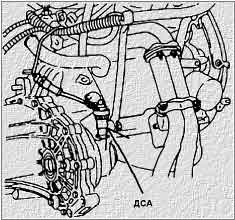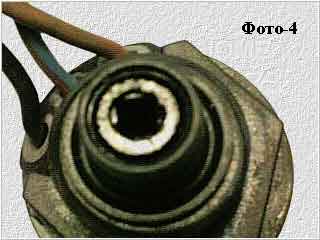Vehicle speed sensor (2112-384301)

Encyclopedia of radio electronics and electrical engineering /
Automobile. Electronic fuel injection
 Comments on the article
Comments on the article
The vehicle speed sensor (DSA) is designed on the principle of the Hall effect and outputs a frequency-pulse signal to the controller. The frequency of the signal is directly proportional to the speed of the vehicle. The controller uses this signal to control the engine idle and, through the idle speed controller, controls the air supply bypassing the throttle. DSA generates approximately 6004 pulses for every kilometer traveled by the vehicle. According to the time interval between pulses, the controller determines the speed of the vehicle. In addition, this signal can be used by the speedometer installed on the instrument panel. The appearance of the vehicle speed sensor is shown in photo 1.
DSA is installed on the gearbox (see photo 2) on the speedometer drive mechanism.

It is dismantled after (with the ignition off) disconnecting the contact connector and the speedometer drive cable (if installed) by unscrewing the sensor from the speedometer drive. Installation of DSA is carried out in the reverse order of dismantling. In case of malfunctions in the DSA connection circuit, the controller enters the code "24" into the RAM and lights the "CHECK ENGINE" lamp, thus indicating the need for diagnostics. One of the pronounced symptoms of a malfunction of the speed sensor is the stop of the engine at X.X. when the vehicle is rolling. However, one should not forget that a similar situation can occur with temporary malfunctions of the mass air flow sensor (MAF), but the "CHECK ENGINE" lamp, in this case, does not always light up. On this basis, it is possible to preliminarily judge which particular sensor is out of order. Checking the performance of the DSA should begin with the presence of grounding on pin "3" and supply voltage (+12V.) on pin "1". Checking the pulse signal on pin "2" should be carried out with the rotation of the drive wheels at a speed of at least 5 km / h. I recommend measuring with a digital multimeter or an oscilloscope. To check the "1" and "3" contacts of the DSA, the use of continuity is allowed. Typical symptoms of a malfunction of the speed sensor or its circuit include stopping the engine when shifting gears and coasting, errors in the speedometer readings.
Most often, the failure of the DSA is associated with the operation of the speedometer cable. If this cable has any burrs, breaks on its surface, or its rotation in a protective sheath is simply difficult, this can lead to failure of the speed sensor (see photos 3 and 4). In addition, often because of this reason, the speed sensor fails precisely at high speeds. In photo 3, the metal rod that transmitted the rotation melted the plastic and, as you can see in the photo, just fell out. On the other hand, the speedometer cable simply broke its seat and, accordingly, ceased to be fixed in it, which led to the failure of the normal operation of the speedometer (see photo 4). Since the sensor circuit was not damaged, the "CHECK ENGINE" lamp did not light up due to the absence of fixed errors in this circuit. In this case, the problem was solved by simply replacing the speedometer cable and speed sensor with new ones. To avoid this situation, while the speedometer cable is in good condition, it should be lubricated with engine oil.


Photos 5, 6 and 7 show another version of the speed sensor (301.3843).
Publication: cxem.net
See other articles Section
Automobile. Electronic fuel injection
 Read and write useful comments on this article.
Read and write useful comments on this article.
<< Back
 Latest news of science and technology, new electronics:
Latest news of science and technology, new electronics:
Machine for thinning flowers in gardens
02.05.2024
In modern agriculture, technological progress is developing aimed at increasing the efficiency of plant care processes. The innovative Florix flower thinning machine was presented in Italy, designed to optimize the harvesting stage. This tool is equipped with mobile arms, allowing it to be easily adapted to the needs of the garden. The operator can adjust the speed of the thin wires by controlling them from the tractor cab using a joystick. This approach significantly increases the efficiency of the flower thinning process, providing the possibility of individual adjustment to the specific conditions of the garden, as well as the variety and type of fruit grown in it. After testing the Florix machine for two years on various types of fruit, the results were very encouraging. Farmers such as Filiberto Montanari, who has used a Florix machine for several years, have reported a significant reduction in the time and labor required to thin flowers.
... >>
Advanced Infrared Microscope
02.05.2024
Microscopes play an important role in scientific research, allowing scientists to delve into structures and processes invisible to the eye. However, various microscopy methods have their limitations, and among them was the limitation of resolution when using the infrared range. But the latest achievements of Japanese researchers from the University of Tokyo open up new prospects for studying the microworld. Scientists from the University of Tokyo have unveiled a new microscope that will revolutionize the capabilities of infrared microscopy. This advanced instrument allows you to see the internal structures of living bacteria with amazing clarity on the nanometer scale. Typically, mid-infrared microscopes are limited by low resolution, but the latest development from Japanese researchers overcomes these limitations. According to scientists, the developed microscope allows creating images with a resolution of up to 120 nanometers, which is 30 times higher than the resolution of traditional microscopes. ... >>
Air trap for insects
01.05.2024
Agriculture is one of the key sectors of the economy, and pest control is an integral part of this process. A team of scientists from the Indian Council of Agricultural Research-Central Potato Research Institute (ICAR-CPRI), Shimla, has come up with an innovative solution to this problem - a wind-powered insect air trap. This device addresses the shortcomings of traditional pest control methods by providing real-time insect population data. The trap is powered entirely by wind energy, making it an environmentally friendly solution that requires no power. Its unique design allows monitoring of both harmful and beneficial insects, providing a complete overview of the population in any agricultural area. “By assessing target pests at the right time, we can take necessary measures to control both pests and diseases,” says Kapil ... >>
 Random news from the Archive
Random news from the Archive
Reverse contraceptive
19.01.2016
One day, German carpenter Clemens Bimek saw a TV show about human anatomy that led him to the idea of a radically new solution to the problem of male contraception. In 2000, he brought his development to patenting, and in 2009 he implanted (with the help of a surgeon, of course) this test device for himself.
The system, called Bimek SLV, uses two shutoff valves that are implanted in the musculoskeletal organ sac. Each valve is made from non-magnetic metal components and a biocompatible polymer used in medical implants. The valves attach to the paired vas deferens and cut into each canal. After implantation, the process of opening and closing the valve occurs by pressing a switch through the skin.
With the valve closed, the spermatozoa are diverted away from the duct and ejected into the surrounding tissue, where they should in theory be absorbed. In order to prevent accidental opening of the valve and, accordingly, an unexpected release of liquid, a safety device is provided in the device, which must be kept pressed to open the valve.
The operation on the inventor was performed under local anesthesia, and he could observe the process. All the past six years since implantation, the device has been working perfectly, and the spermiogram shows that his native ejaculate does not contain spermatozoa. When the rumor about the device spread among the masses, 200 men turned to the inventor, ready to participate in the experiments. Bimek is now working with doctors to prepare the device for clinical trials that are due to begin this year with 25 volunteers.
However, many urologists have raised concerns about the safety of the device. Some suggest a rejection reaction, despite the fact that the materials used in the device have long been used in implants. Others say that scar tissue can form at the junctions of the channels with the device, which will prevent the movement of the ejaculate. And the liquid itself can thicken and become inactive if the valves are kept closed for a long time.
|
 News feed of science and technology, new electronics
News feed of science and technology, new electronics
 We recommend downloading in our Free technical library:
We recommend downloading in our Free technical library:
▪ site section Lecture notes, cheat sheets
▪ Everyday Practical Electronics magazines (annual archives)
▪ book Popular digital circuits. Shilo V.L., 1989
▪ article by Alfred Adler. Famous aphorisms
▪ article Work on inset sewing machines. Standard instruction on labor protection
▪ article Triac regulator with overload protection. Encyclopedia of radio electronics and electrical engineering
▪ reference book Service menus of foreign TVs. Book #6
 Leave your comment on this article:
Leave your comment on this article:
 All languages of this page
All languages of this page
Home page | Library | Articles | Website map | Site Reviews

www.diagram.com.ua
2000-2024













 Arabic
Arabic Bengali
Bengali Chinese
Chinese English
English French
French German
German Hebrew
Hebrew Hindi
Hindi Italian
Italian Japanese
Japanese Korean
Korean Malay
Malay Polish
Polish Portuguese
Portuguese Spanish
Spanish Turkish
Turkish Ukrainian
Ukrainian Vietnamese
Vietnamese
 Leave your comment on this article:
Leave your comment on this article: